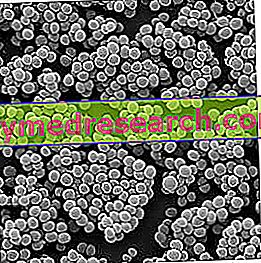What is rice vinegar?
Rice vinegar ( rice vinegar in iglese) is a condiment with an acid taste, obtained by fermenting starchy rice seeds (botanical species Oryza sativa ).
Traditional ingredient of Chinese, Japanese, Korean and Vietnamese cuisine, today rice vinegar is also widespread in the West, where it arrived (together with sake) mainly thanks to the gohan rice recipe (widely used in sushi).

Rice vinegar is a food that is almost totally devoid of calories and has an unattractive nutritional content.
It is distinguished from the most common wine and apple vinegars due to its softer taste and greater sweetness.
Note : Mirin is a drink similar to rice vinegar which also contains a percentage of ethyl alcohol.
Rice vinegar VS Rice wine vinegar
Rice vinegar is not synonymous with rice wine vinegar, which represents a different seasoning.
Both products are based on fermented rice but, while rice vinegar is obtained directly from inoculated rice, rice wine vinegar is obtained from the alcoholic beverage based on the same raw material.
Types
Chinese rice vinegar
Most Chinese vinegars are not produced directly from rice, but from "huangjiu" (an alcoholic beverage made from the same cereal).
Depending on the type, Chinese rice vinegar can be light or dark, yellow, red, brown or black.
It has a stronger taste than Japanese, but more delicate than western products (such as wine or apples). Moreover, except for the black type, Chinese rice vinegars are even sweeter.
These taste differences make it difficult to replace rice vinegar with other types of western vinegar, and vice versa.
The equivalence between ½ tablespoon of wine vinegar and 1 tablespoon of prized black vinegar is defined in Chinese cookbooks. In recipes that require 4 teaspoons of red rice vinegar, these can be replaced with only 3 teaspoons of wine vinegar.
White rice vinegar
White rice vinegar is a light yellow liquid (almost colorless), with a fairly high acetic acid content compared to other Chinese products, but still less acidic and more delicate than in Westerners.
Black maple rice
Black rice vinegar is very dark in color and has an intense, almost smoky flavor; the most prized is the Chinkiang.
Typically produced with black glutinous rice (also called "sweet rice"), it is widespread in southern China (Zhenjiang) and Hong Kong; alternatively it can also contain millet or sorghum.
In northern China, a rather different black vinegar is produced, based on sorghum, peas, barley, bran and chaff.
Red rice vinegar
Red rice vinegar is produced from fermented rice. Previously inoculated with the yeast Monascus purpureus, the seeds acquire a typically ruby color and a particular flavor, which are subsequently transferred to vinegar.
Japanese rice vinegar
Japanese white-yellow rice vinegar
With only 5% acetic acid, Japanese rice vinegar is pale yellow and has a soft and delicate taste. It can be produced directly from rice seeds (yonezu) or from sake (kasuzu). These two types of vinegar are used in the preparation of typical recipes such as: sunomono, tsukemono and nimono, but also in the marinades for fish and meat.
Japanese seasoned rice vinegar
"Seasoned" Japanese vinegar (awasezu) is a condiment based on rice vinegar, sake, salt and sugar; it is notoriously used for the preparation of sushi and in the West as an alternative dressing along with ginger and sesame.
Japanese black rice vinegar
In Japan, a more tenuous black vinegar is produced than the Chinese one (kurozu), obtained by direct fermentation of the rice. Considered as a diet drink, it is hypothesized that this black rice vinegar has its own anti-cancer properties (demonstrated in vivo on rats and in vitro on human cancer cells).
Korean rice vinegar
Korean rice vinegar is known in the mother tongue as ssal sikcho or micho. It is produced by inoculating the varieties of glutinous rice (chapssal) or brown (hyeonmi) with nuruk, a biological starter typical of the area.
Vietnamese rice vinegar

The "giấm bỗng" variant, produced from "n'hp cái hoa vàng" rice, is famous for its spicy and spicy taste.
Vietnamese rice vinegar is an essential ingredient for various local recipes (especially soups).
Rice Vinegar and Health
Is rice vinegar good for you?
Many claim that rice vinegar has a beneficial effect on health; however, not all the following hypotheses are actually verifiable.
- Digestive properties and absorption improvement: being acid, it can improve digestion and facilitate the absorption of some nutrients (calcium, iron, potassium and certain vitamins); in this it is not different from any other type of vinegar.
Note : this applies if the meal is protein-free, which promotes the release of gastric acids and does not require lowering the pH with food.
- Antiseptic property: attributed mainly to brown rice vinegar which, in particular, seems to exert an antibacterial effect.
- Hepatoprotective properties: according to a study published in 2011 by the "Journal of Clinical Biochemistry and Nutrition", kurozu vinegar could exert a protective effect on the liver.
- Source of amino acids: useful only if there is a lack of certain amino acids in the diet.
- Antioxidant properties: it is not clear which nutrients are attributed; if so, it would help reduce the body's oxidative stress.
- Slimming: it is a popular belief but completely denied by scientific research.
- Nourishing for the skin: combined with water and oil it would seem a remedy for dry skin. It is not a particularly effective solution.



